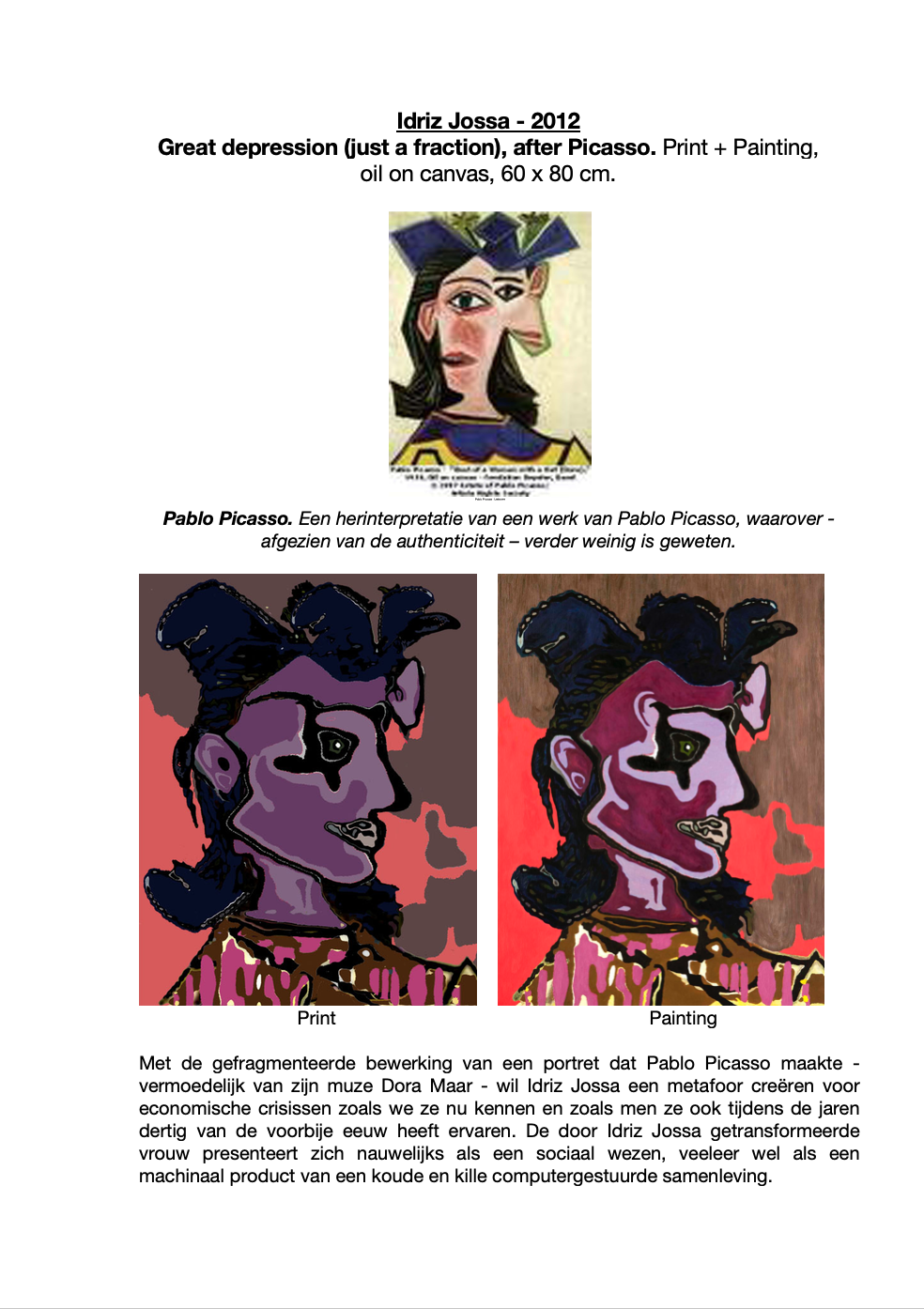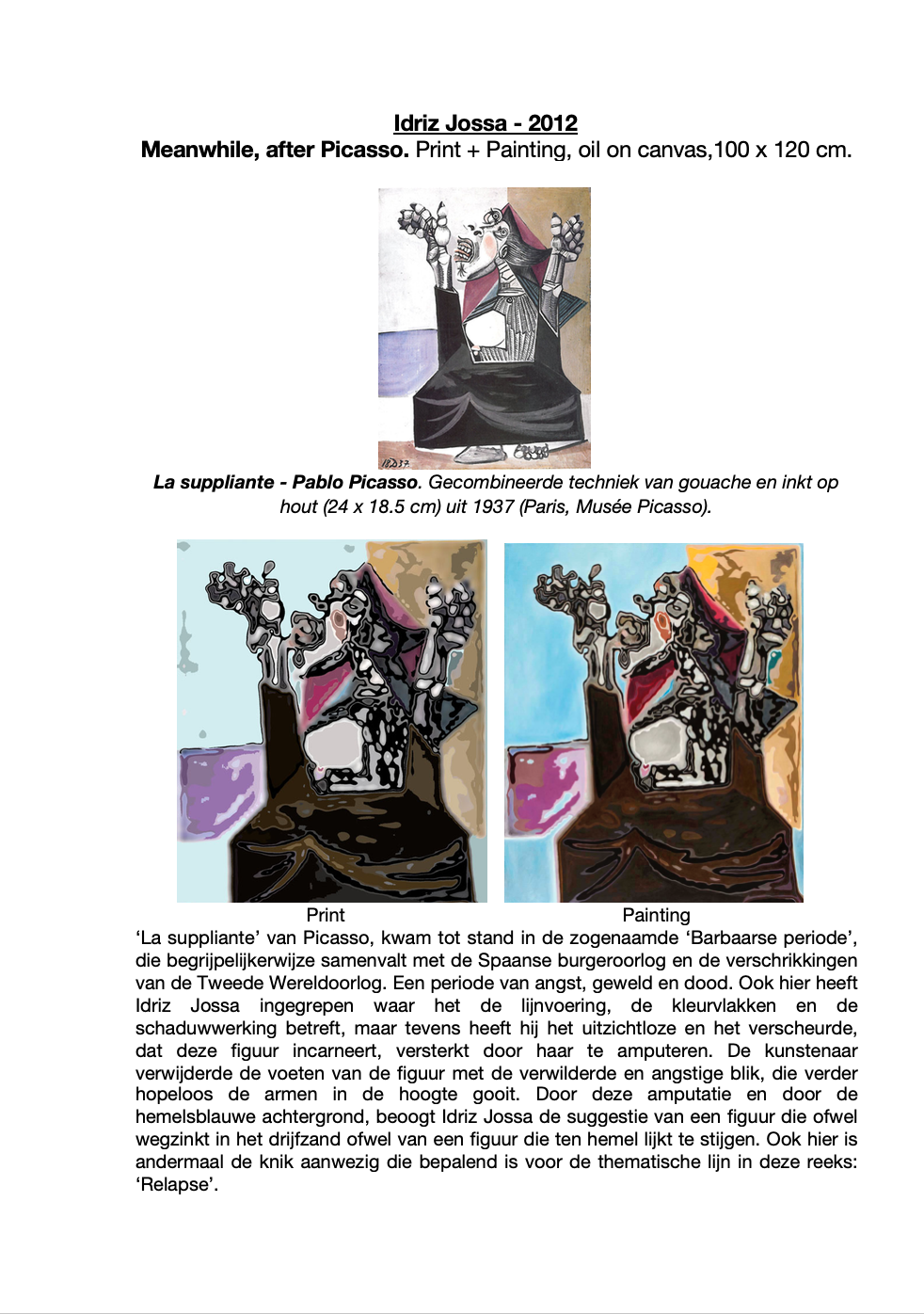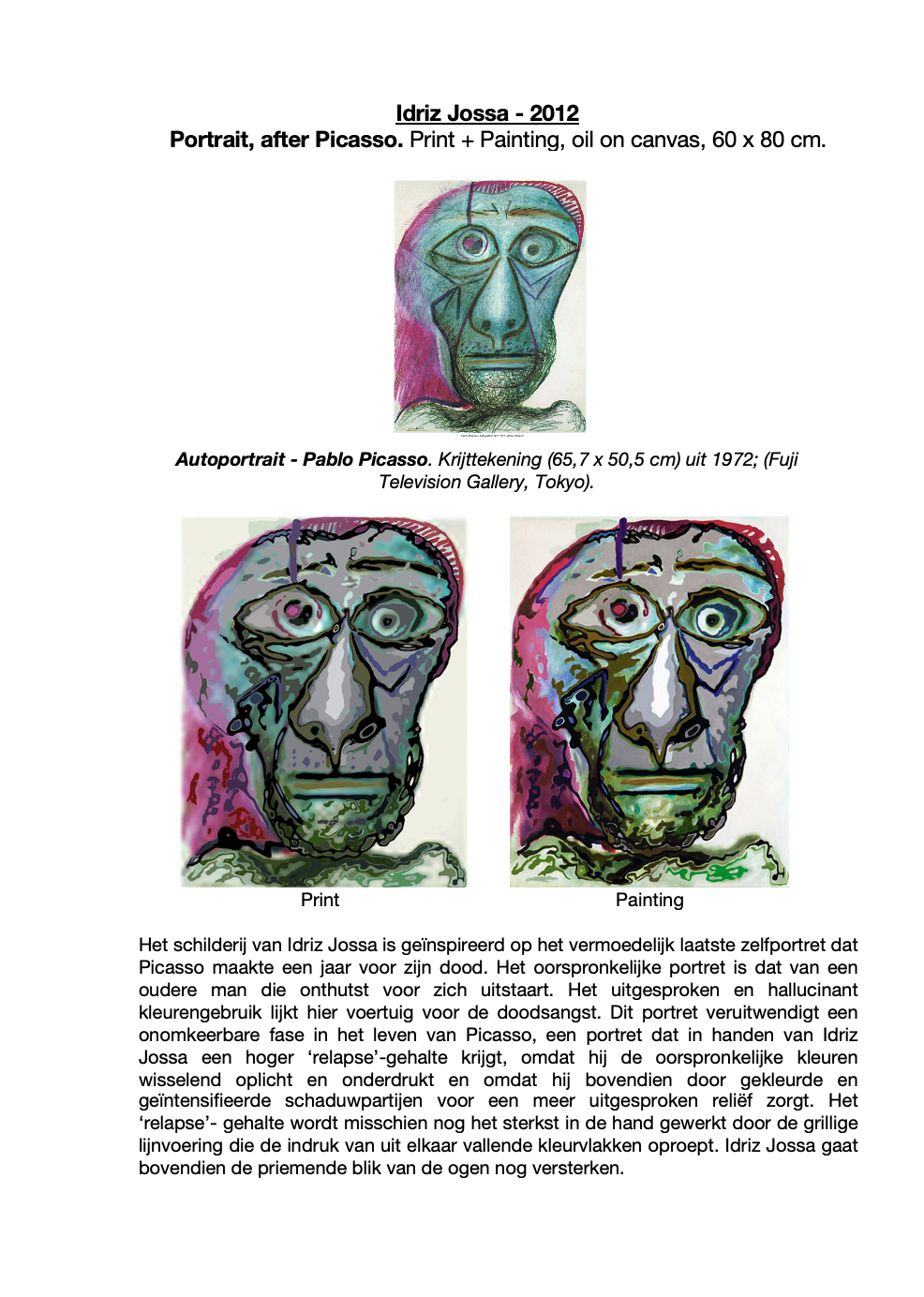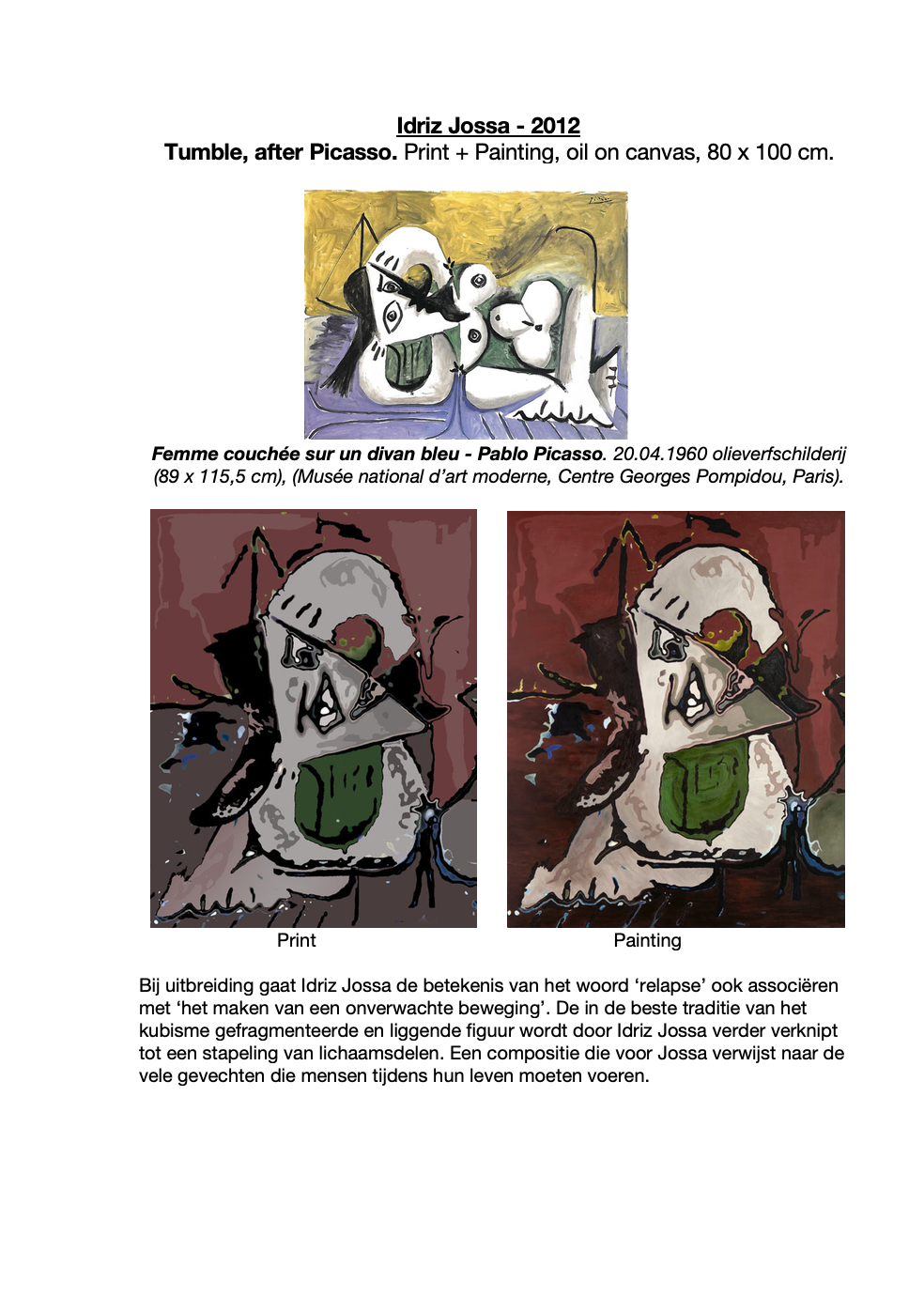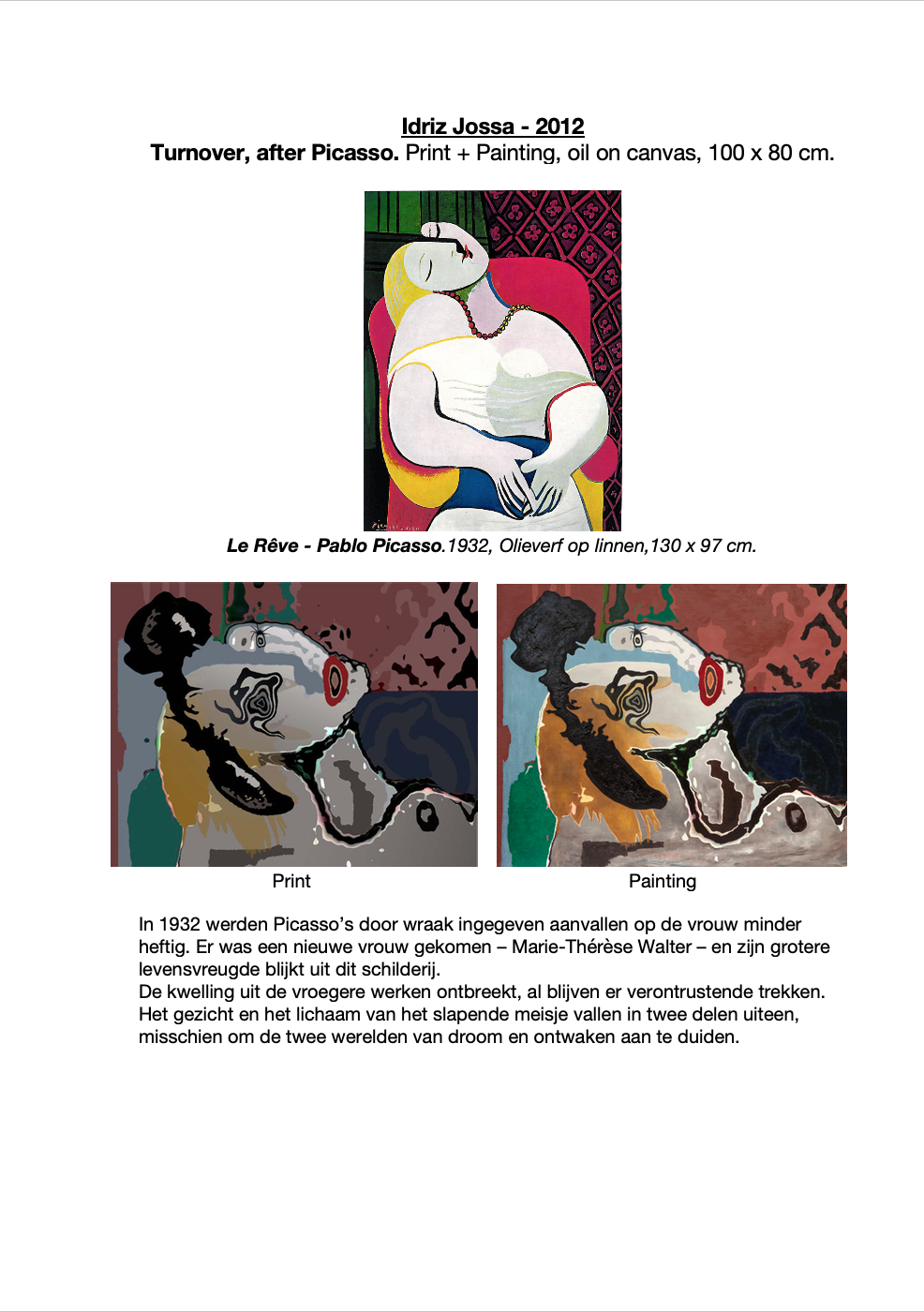RELAPSE After Picasso
Idriz Jossa explores painting.
>> nederlandse versie>> version française
The thinking and acting man is distinguished by his immanent striving to give form to his surroundings. Social organisation, its accompanying evolution and the individual implications these generate are essential to what we call culture. Idriz Jossa is a fully-fledged member of this community, in the sense that his passion for giving things form is almost boundless. After fashion, performance, readymade and installation art, Idriz Jossa has now turned his attention to painting. But this artist is not throwing himself into painting out of any self-important self-evidence. He turns to the great masters, but he never lapses into shameless plagiarism: his referencing is always personal and critical. That Idriz Jossa probes the pictorial qualities of Pablo Picasso should come as no surprise. That Spanish master was not only one of the most influential painters of the last century, he also – and above all else - explored painting. Among other things, his many styles are a result of this. Expression, abstraction, the formal, the surrealistic and various other aspects all feature in his oeuvre. Idriz Jossa understands this; he therefore quotes and reinterprets Picasso’s work across different periods. This exploration and reinterpretation of work by a historical figure has meanwhile given rise to a series works on the theme ‘Relapse’. Regression, reversion, recession, and this word’s many other meanings, all have a universal human dimension. ‘Relapse’ is an essential aspect of every individual and of every society and is very much a part of our present-day world, which sometimes seems to be losing direction.
As his point of departure, Idriz Jossa takes images of Picasso paintings and digitally manipulates them, so that their lines and colour planes run and various components of the image silt up. At this stage, an important mental and creative shift becomes apparent: a consciousness of the individuality of the one painter’s artistic impulse gives rise to a dialogue and this, in its turn, leads to an altered aesthetic and ditto way of seeing in the other painter. Idriz Jossa allows original colours to disappear and replaces them with new colours. This interaction enables him to generate depth and banish the flatness from the two-dimensional depiction, all the more so, because in Idriz Jossa’s work shadows are not created by the use of black or gradations of black, but by the effective use of colour planes. Touches of colour from the original work also sometimes still reverberate in the composition. This pictorial play creates expressivity.
Important in this reinterpretation of the great master’s work is the fact that Idriz Jossa - by analogy with Picasso and many others from the beginning of the twentieth century - restores the black outline’s right to exist. The use of black contours is, after all, relatively rare in present-day painting. What’s more, the inconstancy of the line he uses underpins Idriz Jossa’s theme-related search for the turning point, when there is talk of relapse, or regression. Idriz Jossa’s unpredictable line rends Picasso’s original composition asunder. It runs criss-cross through the visual elements, it deconstructs. Moreover, his reinterpretation gains a dramatic quality, when the viewer becomes aware that the dismembered images are those of people. This property repeatedly reconnects the artist with the current unrest in the world.
The referencing of the painting of the past century is a recurring aspect of Idriz Jossa’s work, not just because of the referencing per se, but also because of his approach to the expressive qualities of colour, of the line used and of the handling of space. Thanks to deformations and the occasional added foreign element, there are also connotations with the world of abstraction and the surreal. Idriz Jossa’s falling back on the work of other artists does not stem from a movement comparable with that of artists such as Mike Bidlo and Sherrie Levine, to name just two practitioners of Appropriation Art. Such artists ask questions about originality and copying and undermine modernistic ambitions regarding uniqueness and authenticity. Idriz Jossa, on the other hand, is driven by a search for the essence of painting. He is nevertheless a postmodern artist, not so much because of the abovementioned referencing, but mainly because of his scepticism and his aspiration to reconcile ‘high and low art’ via painting and computer processing.
Idriz Jossa: I saddle the icons of art history with the trauma of the 21st century. Certainties from last century make way for the innovations of this century. Is the old able to withstand this? Or will it have to evolve along and redefine itself… To change is to lead.
RELAPSE After Picasso
Idriz Jossa exploreert de schilderkunst.
De denkende en handelende mens onderscheidt zich door zijn immanent streven om aan zijn ‘umwelt’ vorm te geven. Het zich maatschappelijk organiseren, de daarbij horende evolutie en de individuele implicaties hiervan, zijn wezenlijk voor wat wij cultuur noemen. Idriz Jossa is een volwaardig lid van die gemeenschap, in die zin, dat zijn gedrevenheid om de dingen vorm te geven, bijna niet te stuiten is. Na de mode, performance, installatie- en objectenkunst oriënteert hij zich nu op de schilderkunst. De artiest werpt zich niet op de schilderkunst vanuit een zelfingenomen vanzelfsprekendheid. Hij gaat te rade bij grote meesters, echter zonder dat dit resulteert in een schaamteloos plagiëren: zijn refereren blijft persoonlijk en kritisch. Dat Idriz Jossa peilt naar de picturale kwaliteiten van Pablo Picasso, mag niet verbazen. Deze Spaanse meester wordt namelijk niet alleen bestempeld als één van de meest gezaghebbende schilders van de voorbije eeuw, maar ook en vooral exploreerde hij de schilderkunst. Zijn vele stijlen zijn, onder andere, hiervan een gevolg. De expressie, de abstractie, het formele, het surreële en diverse andere aspecten, alle komen ze aan bod in zijn oeuvre. Dat heeft Idriz Jossa begrepen en daarom citeert en herinterpreteert deze kunstenaar ook werk van Pablo Picasso uit uiteenlopende periodes. Dit aftasten en herinterpreteren van werk van een historische figuur heeft hier geleid tot een reeks werken met als rode draad ‘Relapse’. Terugval, inzinking, regressie en de vele andere betekenissen van dit woord hebben een universeel menselijke dimensie. ‘Relapse’ is een wezenlijk deel van elk individu en van iedere samenleving en niet in het minst van onze huidige wereld, die soms de pedalen lijkt kwijt te raken.
De afbeeldingen van de schilderingen van Pablo Picasso die Idriz Jossa als vertrekpunt neemt, worden digitaal bewerkt met als gevolg dat lijnen en kleurvlakken gaan vervloeien en uiteenlopende componenten van het beeld gaan dichtslibben. Dit is het stadium waarin zich een belangrijke mentale en creatieve kentering manifesteert: vanuit het bewustzijn van de eigenheid van de schilderimpuls bij de ene schilder, komt een dialoog tot stand, die bij de andere schilder gaat leiden naar een gewijzigde esthetiek en een dito kijkgedrag. Idriz Jossa laat enerzijds oorspronkelijke kleurpartijen verdwijnen en gaat anderzijds nieuwe kleurvlakken opzetten. Door deze wisselwerking genereert de kunstenaar diepte en bant hij de vlakheid uit de tweedimensionale voorstelling, temeer omdat bij deze artiest, schaduwpartijen niet tot stand komen door zwart of een gradatie daarvan, maar door het doelmatig aanwenden van kleurvlakken. Soms zinderen er in de compositie ook nog kleurentoetsen na van het oorspronkelijk werk. Dit picturale spel creëert expressiviteit.
Belangrijk in dit herinterpreteren van het werk van de grote meester, is het gegeven dat Idriz Jossa naar analogie van Pablo Picasso -en vele anderen uit het begin van de twintigste eeuw - de zwarte omtreklijn terug bestaansrecht geeft. Het gebruik van zwarte contouren is in de tegenwoordige schilderkunst immers een minder frequent gegeven. De grilligheid van de door Idriz Jossa gehanteerde lijn ondersteunt bovendien zijn met het thema verbonden zoektocht naar het kantelmoment, wanneer er sprake is van ‘relapse’, van een terugval. De onvoorspelbare lijn van Idriz Jossa verscheurt de oorspronkelijke compositie van Picasso. Ze loopt kriskras door de beeldelementen, ze deconstrueert. De herinterpretatie krijgt bovendien een dramatisch gehalte, wanneer de toeschouwer zich ervan bewust wordt dat de uiteengereten afbeeldingen die van mensen betreft. Een sfeer die de kunstenaar herhaaldelijk verbindt met de momentele onrust in de wereld.
Het refereren aan de schilderkunst van de voorbije eeuw is weerkerend in het werk van Idriz Jossa, niet alleen omwille van het verwijzen ‘an sich’, maar ook omwille van zijn benadering van de expressieve kwaliteiten van de kleur, van de gehanteerde lijnvoering en van de benadering van de ruimte. Evenzeer zijn er door deformaties en soms toegevoegde vreemde elementen connotaties aan de wereld van de abstractie en van het surreële. Het terugvallen op werk van andere kunstenaars gebeurt bij Idriz Jossa niet vanuit een beweging die vergelijkbaar is met kunstenaars als Mike Bidlo en Sherrie Levine, om maar een paar kunstenaars van de ‘Appropiation Art’ te noemen. Deze kunstenaars stellen immers vragen omtrent originaliteit en kopie en ondergraven de modernistische ambitie met betrekking tot oorspronkelijkheid en authenticiteit. Idriz Jossa wordt gedreven door de zoektocht naar het wezen van de schilderkunst. Hij is niettemin wel een postmodernistisch kunstenaar, niet zozeer omwille van het vermelde refereren, maar vooral omwille van het scepticisme en van zijn streven om ‘high and low art’, via schilderen en computerbewerking, met elkaar te verzoenen.
Idriz Jossa: Ik zadel de iconen uit de kunstgeschiedenis met het trauma van de 21ste eeuw op. Zekerheden uit vorige eeuw, maken plaats voor het nieuwe uit deze eeuw. Is het oude daartegen bestand? Of moet het mee evolueren, zich herdefiniëren... Veranderen is leiden.
RELAPSE d’après Picasso
Idriz Jossa et son exploration de l’art pictural.
L’homme pensant et agissant se caractérise par son ambition immanente à modeler le monde qui l’environne. L’organisation sociale, l’évolution qui en découle et ses implications personnelles sont des éléments essentiels de ce que nous appelons culture. Idriz Jossa est un membre à part entière de cette communauté: son aspiration passionnelle à vouloir donner forme aux objets est en effet presque irrésistible. Après la mode et la performance, après l’art de l’installation et des objets, il s’oriente à présent vers la peinture. Ce n’est cependant pas au départ d’une évidence prétentieuse que l’artiste se lance dans la peinture: il consulte les grands maîtres, mais sans que cela n’aboutisse à un plagiat éhonté: son approche demeure personnelle et critique. Qu’Idriz Jossa veuille sonder les qualités picturales de Pablo Picasso, ne doit pas nous étonner. Le maître espagnol n’est pas seulement considéré comme l’un des peintres les plus influents du siècle dernier, mais aussi et surtout comme un explorateur de l’art de la peinture. Ses styles multiples en sont parmi d’autres la conséquence. L’expression, l’abstraction, le formel, le surréel et plusieurs autres aspects se retrouvent tous dans son oeuvre. Idriz Jossa l’a bien compris et c’est la raison pour laquelle il cite et réinterprète les oeuvres de Picasso de différentes époques. Cette recherche et cette réinterprétation de l’oeuvre d’un artiste historique a abouti à une série de 7 tableaux, dont le thème est ‘Relapse’. Les significations de ce mot, telles que rechute, dépression, régression et de nombreuses autres, ont une dimension humaine universelle. ‘Relapse’ est une partie essentielle de tout individu et de toute société et en particulier de notre monde actuel qui semble quelquefois avoir perdu les pédales.
Idriz Jossa prend comme point de départ des reproductions de tableaux de Pablo Picasso, qu’il soumet à un traitement digital, ce qui a comme effet que traits et plages de couleurs se mélangent et que des composantes variées de l’image vont en quelque sorte s’envaser. C’est le moment où un renversement mental et créatif important se manifeste: la prise de conscience de la spécificité de son élan créateur chez l’un des deux est l’amorce d’un dialogue qui va mener chez l’autre peintre à une esthétique et à un comportement de l’observation modifiés. D’une part Idriz Jossa fait disparaître des plages de couleur originales, d’autre part il en recrée de nouvelles. Au travers de cette interaction, l’artiste génère une certaine profondeur et il bannit ainsi l’uniformité de la représentation bidimensionnelle; et cela est d’autant plus vrai que chez cet artiste les plans d’ombre ne sont pas produits par le noir, ni par ses gradations, mais bien par une utilisation efficace de plans de couleur. Dans la composition vibrent parfois encore quelques accents de couleur de l’oeuvre originale, un jeu pictural qui crée de l’expressivité.
Un élément important dans cette réinterprétation de l’oeuvre du grand maître est le fait qu’Idriz Jossa - et cela par analogie avec Pablo Picasso et avec nombre d’autres du début du vingtième siècle – remet en honneur le trait noir pour les contours. L’utilisation de contours noirs est en effet devenu moins fréquent dans la peinture contemporaine. Le caractère capricieux du trait telle qu’il est mis en oeuvre par Idriz Jossa souligne en outre sa quête, reliée au thème, du moment crucial où il est question de ‘relapse’, de la rechute. Le trait imprévisible d’Idriz Jossa déchire la composition originale de Picasso: il court dans tous les sens à travers les élements picturaux et les déconstruit. La réinterprétation atteint en outre une dimension dramatique lorsque le spectateur prend subitement conscience du fait que ces images déchiquetées sont celles d’êtres humains. Il se crée ainsi une atmospère qui relie continuellement l’artiste au monde troublé d’aujourd’hui.
Un élément récurrent et important dans l’oeuvre d’Idriz Jossa est la référence à la peinture du siècle dernier, important non seulement pour la référence en soi, mais aussi pour sa façon d’appréhender les caractéristiques expressives de la couleur, son maniement du trait et son approche de l’espace. Les déformations et l’ajout occasionnel d’éléments insolites constituent également des connotations au monde de l’abstraction et du surréel. Chez Idriz Jossa cette référence à l’oeuvre d’autres artistes ne part du même mouvement que chez d’autres artistes comme Mike Bidlo et Sherrie Levine, pour ne citer que ces deux-là appartenant à l’école dite ’Appropriation Art’. Ceux-ci questionnent en effet l’originalité et la copie et sapent l’ambition des modernistes sur le plan de l’originalité et de l’authenticité. Idriz Jossa par contre est mû par la quête de l’essence de l’art pictural. Malgré cela, il est bien un artiste postmoderniste, non pas tellement pour les références dont question ci-dessus, mais surtout pour son scepticisme et son aspiration à concilier le ‘high and low art’ au travers de la peinture et du traitement informatique.

